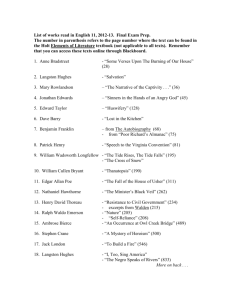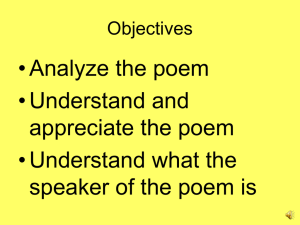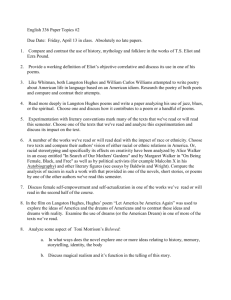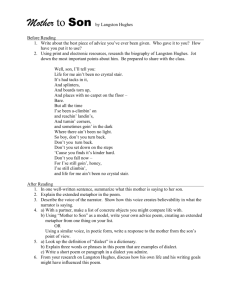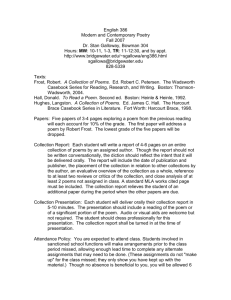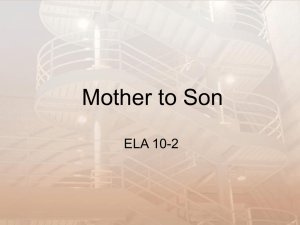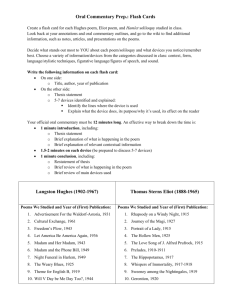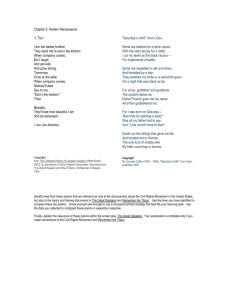the Langston Hughes reading guide
advertisement
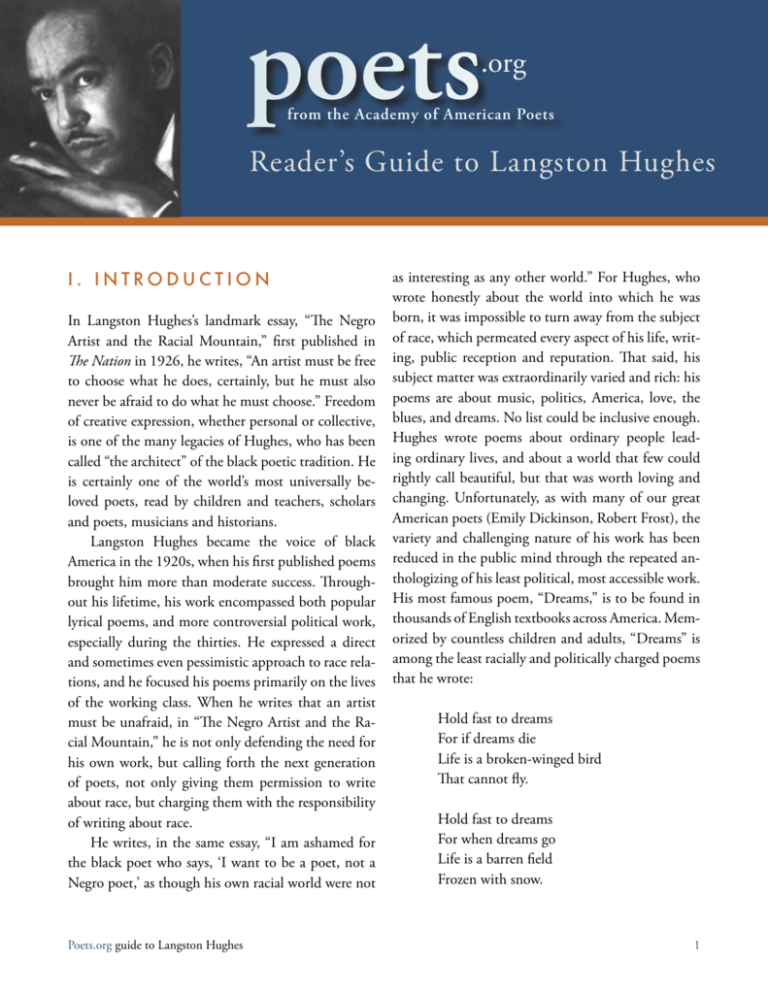
poets p .org from the Academy of American Poets Reader’s Guide to Langston Hughes I. INTRODUCTION In Langston Hughes’s landmark essay, “The Negro Artist and the Racial Mountain,” first published in The Nation in 1926, he writes, “An artist must be free to choose what he does, certainly, but he must also never be afraid to do what he must choose.” Freedom of creative expression, whether personal or collective, is one of the many legacies of Hughes, who has been called “the architect” of the black poetic tradition. He is certainly one of the world’s most universally beloved poets, read by children and teachers, scholars and poets, musicians and historians. Langston Hughes became the voice of black America in the 1920s, when his first published poems brought him more than moderate success. Throughout his lifetime, his work encompassed both popular lyrical poems, and more controversial political work, especially during the thirties. He expressed a direct and sometimes even pessimistic approach to race relations, and he focused his poems primarily on the lives of the working class. When he writes that an artist must be unafraid, in “The Negro Artist and the Racial Mountain,” he is not only defending the need for his own work, but calling forth the next generation of poets, not only giving them permission to write about race, but charging them with the responsibility of writing about race. He writes, in the same essay, “I am ashamed for the black poet who says, ‘I want to be a poet, not a Negro poet,’ as though his own racial world were not Poets.org guide to Langston Hughes as interesting as any other world.” For Hughes, who wrote honestly about the world into which he was born, it was impossible to turn away from the subject of race, which permeated every aspect of his life, writing, public reception and reputation. That said, his subject matter was extraordinarily varied and rich: his poems are about music, politics, America, love, the blues, and dreams. No list could be inclusive enough. Hughes wrote poems about ordinary people leading ordinary lives, and about a world that few could rightly call beautiful, but that was worth loving and changing. Unfortunately, as with many of our great American poets (Emily Dickinson, Robert Frost), the variety and challenging nature of his work has been reduced in the public mind through the repeated anthologizing of his least political, most accessible work. His most famous poem, “Dreams,” is to be found in thousands of English textbooks across America. Memorized by countless children and adults, “Dreams” is among the least racially and politically charged poems that he wrote: Hold fast to dreams For if dreams die Life is a broken-winged bird That cannot fly. Hold fast to dreams For when dreams go Life is a barren field Frozen with snow. 1 Though this is a poem of hope, it seems significant that he writes, in the second stanza, “when” instead of “if,” a testimony to the difficulty of his own life, and the lives he so closely observed in his work. A later poem, “Dream Variations,” articulates that very dream and is only slightly less well-known, or known primarily because of the last line, which became the title of John Howard Griffin’s seminal work on race relations in the sixties. To fling my arms wide In some place of the sun, To whirl and to dance Till the white day is done. Then rest at cool evening Beneath a tall tree While night comes on gently, Dark like me— That is my dream! To fling my arms wide In the face of the sun, Dance! Whirl! Whirl! Till the quick day is done. Rest at pale evening . . . A tall, slim tree . . . Night coming tenderly Black like me. This poem is much more characteristic of how Hughes was able to use image, repetition, and his almost hypnotic cadence and rhyme to marry political and social content to the structures and form of poetry. Some of Hughes’s major poetic influences were Walt Whitman, Carl Sandburg, Paul Laurence Dunbar, and Claude McKay. He also recognized W.E.B. Dubois as a master of prose, and the long ignored stories and novels of Charles Chesnutt, which have recently gained more critical attention for both their structural complexity and political content. It was the marriage of these widely varying aesthetics, modernism mixed with an almost religious devotion to the Poets.org guide to Langston Hughes power of repetition and musicality in the blues, that gave rise to Hughes’s voice, which sounded like no other voice that came before it. Hughes once wrote, “Our folk music, having achieved world-wide fame, offers itself to the genius of the great individual American composer who is to come.” The idea of using the familiarity of music with the structural complications of other traditions is illustrated by a number of Hughes poems. Some of his poems, such as “Po’ Boy Blues,” are so much in the Blues tradition that it’s impossible to read them without hearing the 12-bar blues behind the words. When I was home de Sunshine seemed like gold. When I was home de Sunshine seemed like gold. Since I come up North de Whole damn world’s turned cold. The genius here is not that the poem is so markedly different than the blues, but that presenting this form as poetry allowed the blues tradition the intellectual respect it deserved; putting the blues on the page demanded that they be taken seriously, and opened the door to future study and scholarship. However, just as Hughes believed that folk music would inspire a virtuoso composer to transform it, he himself transformed the language of poetry by integrating blues structures into poems such as “The Weary Blues.” Droning a drowsy syncopated tune, Rocking back and forth to a mellow croon, I heard a Negro play. Down on Lenox Avenue the other night By the pale dull pallor of an old gas light He did a lazy sway . . . He did a lazy sway . . . To the tune o’ those Weary Blues. With his ebony hands on each ivory key He made that poor piano moan with melody. O Blues! 2 Swaying to and fro on his rickety stool He played that sad raggy tune like a musical fool. Sweet Blues! Coming from a black man’s soul. O Blues! In a deep song voice with a melancholy tone I heard that Negro sing, that old piano moan— “Ain’t got nobody in all this world, Ain’t got nobody but ma self. I’s gwine to quit ma frownin’ And put ma troubles on the shelf.” Thump, thump, thump, went his foot on the floor. He played a few chords then he sang some more— “I got the Weary Blues And I can’t be satisfied. Got the Weary Blues And can’t be satisfied— I ain’t happy no mo’ And I wish that I had died.” And far into the night he crooned that tune. The stars went out and so did the moon. The singer stopped playing and went to bed While the Weary Blues echoed through his head. He slept like a rock or a man that’s dead. This poem is much more structurally complex than “Po’ Boy Blues.” The blues that appear in quotation marks are traditional in form: a line is repeated and then altered. But the poetry surrounding those “traditional” blues/lines is much more difficult to classify; each line seems to be influenced by the blues, but also makes its own form, relying on the repetition of a single rhyme for its power at the end, yet departing radically from the “expected” shape of music. At the beginning, the small, indented explanations almost seem like a longing to burst into song, which doesn’t Poets.org guide to Langston Hughes actually happen until later in the poem. There is a modernist quality to this structure in that it borrows the technique of collage, but it isn’t implemented in quite the same way. The quotations that one finds in Ezra Pound or T. S. Eliot have the effect of dividing traditions, as if poems were being cast off the Tower of Babel. In Hughes’s work, the traditions are united. Formally, however, the poem “Let America be America Again” is far more ambitious. Like Whitman, Hughes uses the technique of anaphora, or repetition, as a rhetorical device that unifies the disparate elements of the poem: I am the poor white, fooled and pushed apart, I am the Negro bearing slavery’s scars. I am the red man driven from the land, I am the immigrant clutching the hope I seek— And finding only the same old stupid plan Of dog eat dog, of mighty crush the weak. I am the young man, full of strength and hope, Tangled in that ancient endless chain Of profit, power, gain, of grab the land! Of grab the gold! Of grab the ways of satisfying need! Of work the men! Of take the pay! Of owning everything for one’s own greed! I am the farmer, bondsman to the soil. I am the worker sold to the machine. I am the Negro, servant to you all. I am the people, humble, hungry, mean— Hungry yet today despite the dream. Beaten yet today—O, Pioneers! I am the man who never got ahead, The poorest worker bartered through the years. These lines seem as if they could have been pulled straight from Whitman’s poem “The Sleepers” except that Hughes is rhyming at the same time, which doubly unifies the stanzas. And where Whitman’s poetry was open and inclusive, Hughes’s poem is more pes3 simistic about the nature of America, even angry. The opening lines, which long for the past: Let America be America again. Let it be the dream it used to be. are transformed by the end of the poem into: O, let America be America again— The land that never has been yet— And yet must be—the land where every man is free. As an American poet, Hughes offers a call to change to his readers as an alternative to Whitman’s optimism. With both his politics and his formal innovations, he has influenced countless poets of different styles and schools in the twentieth and twenty-first century including Yusef Komunyakaa, Afaa Michael Weaver, Kevin Young, Robert Creeley, Frank O’Hara, Gwendolyn Brooks, Rita Dove, Martín Espada, and others. The question for the 21st-century reader of Hughes’s work is how to read his poems without reducing his work to politics or denying the political complexity. He himself saw the politics and poetry as inseparable writing: Most of my own poems are racial in theme and treatment, derived from the life I know. In many of them I try to grasp and hold some of the meanings and rhythms of jazz. I am as sincere as I know how to be in these poems and yet after every reading I answer questions like these from my own people: “Do you think Negroes should always write about Negroes?” “I wish you wouldn’t read some of your poems to white folks.” “How do you find anything interesting in a place like a cabaret?” “Why do you write about black people? You aren’t black.” “What makes you do so many jazz poems?” Poets.org guide to Langston Hughes The formal devices, rhetoric, anaphora, and rhyme as well as his original and compelling integration of the Blues, all of which make his poems so memorable and beloved, come from a cultural tradition that had never had a voice in poetry. In that sense, Hughes’s use of forms was itself political, not just the content of his poems. II. BIOGRAPHY James Langston Hughes was born February 1, 1902, in Joplin, Missouri. His parents divorced when he was a small child, and his father moved to Mexico. He was raised by his grandmother until he was thirteen, when he moved to Lincoln, Illinois, to live with his mother and her husband, before the family eventually settled in Cleveland, Ohio. It was in Lincoln, Illinois, that Hughes began writing poetry. Following graduation, he spent a year in Mexico and a year at Columbia University. During these years, he held odd jobs as an assistant cook, launderer, and a busboy, and traveled to Africa and Europe working as a seaman. In November 1924, he moved to Washington, D.C. Hughes first book of poetry, The Weary Blues, was published by Alfred A. Knopf in 1926. He finished his college education at Lincoln University in Pennsylvania three years later. In 1930 his first novel, Not Without Laughter, won the Harmon gold medal for literature. Hughes, who claimed Paul Lawrence Dunbar, Carl Sandburg, and Walt Whitman as his primary influences, is particularly known for his insightful, colorful portrayals of black life in America from the twenties through the sixties. He wrote novels, short stories and plays, as well as poetry, and is also known for his engagement with the world of jazz and the influence it had on his writing, as in “Montage of a Dream Deferred.” His life and work were enormously important in shaping the artistic contributions of the Harlem Renaissance of the 1920s. Unlike other 4 notable black poets of the period—Claude McKay, Jean Toomer, and Countee Cullen—Hughes refused to differentiate between his personal experience and the common experience of black America. He wanted to tell the stories of his people in ways that reflected their actual culture, including both their suffering and their love of music, laughter, and language itself. Langston Hughes died of complications from prostate cancer in May 22, 1967, in New York. In his memory, his residence at 20 East 127th Street in Harlem, New York City, has been given landmark status by the New York City Preservation Commission, and East 127th Street has been renamed “Langston Hughes Place.” In addition to leaving us a large body of poetic work, Hughes wrote eleven plays and countless works of prose, including the well-known “Simple” books: Simple Speaks His Mind, Simple Stakes a Claim, Simple Takes a Wife, and Simple’s Uncle Sam. He edited the anthologies The Poetry of the Negro and The Book of Negro Folklore, wrote an acclaimed autobiography (The Big Sea) and co-wrote the play Mule Bone with Zora Neale Hurston. III. AN INTERVIEW WITH A FA A M I C H A E L W E AV E R Afaa Michael Weaver, formerly known as Michael S. Weaver, was born in 1951 in Baltimore, Maryland, to working class parents. He attended public schools and graduated as a National Merit finalist at the age of sixteen. After two years at the University of Maryland, he entered the world of factory life alongside his father and uncles and remained a factory worker for fifteen years. These years were a literary apprenticeship during which he wrote and published poetry, short fiction, and freelance journalism. During that time he also started 7th Son Press and Blind Alleys, a literary journal. His first book of poetry, Water Song, was published in 1985 as part of the Callaloo series. He received a NEA fellowship for poetry six months after signing Poets.org guide to Langston Hughes the contract for the collections and left factory life to accept admission into Brown University’s graduate writing program on a full university fellowship, where he completed the M.A. with a focus on theater and playwriting. Concurrently, he completed his B.A. in Literature in English through Excelsior College. His essay “Masters and Master Works: On Black Male Poetics” can be found on Poets.org. Poets.org: How did you first come to study Hughes? What poems were you first drawn to? What poems do you keep coming back to? Which ones have shaped your own work? Weaver: Hughes worked with his good friend Arna Bontemps to produce The Poetry of the Negro, a classic in the history of African-American Anthology-making. I purchased it when I was twenty years old. That along with reading his work as an undergraduate was my introduction. “Mother to Son” and “Daybreak in Alabama” have been favorites of mine, but I have learned the most from his blues poems and “Montage of a Dream Deferred.” When I created the “Bop” poetic form while teaching at Cave Canem (a retreat for African American poets), Hughes’s blues poems were my models and inspiration. Poets.org: I’m interested in something you said in your essay on Black Male Poetics: “In choosing to be an architect, [Hughes] had to imagine his role.” The idea of founding a cultural movement is daunting, and I imagine Hughes was more aware of that responsibility than most. How do you think Hughes imagined his role in shaping the poetic landscape of his time? What was present already for him to build upon or grapple with, and more importantly, how did he transform it? Weaver: Hughes was following Paul Laurence Dunbar, a rather mighty predecessor, as I think Dunbar’s facility with metrics overshadowed Hughes, but Hughes had the persistence and the ability to seize fortuitous circumstance and make the best of things. He did not so much create a cultural movement as much as find his moorings in one into which he was born. He had a kind of native literary sense. So he 5 was perched so as to be able to gradually sense the architectonics of his place in the tradition, which is perhaps best exemplified in his essay “The Negro Artist and the Racial Mountain,” which has been a huge influence on my life and writing. In the naïve ambition common to most younger poets, I wanted to be the fulfillment of that prophesy. Back to Dunbar and Hughes, Hughes had the benefit of “not” being weighed by such an albatross as “plantation poetry,” which was the handiwork of James Whitcomb Riley and other white writers. The southern speech such writers set in minstrel form sounded more like the Hoosier dialect of places like Indiana than Alabama or Mississippi, neither of which were like Virginia. Hughes was in that way free to set more of his own signature on the speech he used in his poetry, speech he observed among black people and then modified. If not the fulfillment of a prophesy in any essay, Hughes was certainly in a continuum. Grieving over a lack of access for his standard speech poetry, Dunbar bemoaned it all in the phrase “a jingle in a broken tongue,” referring to plantation poetry, which was not even accurate representation of black speech patterns. Hughes took up the ways in which black folk “be” at the time and tried to operate out of a basic acceptance of our own humanity, hobbled as he was by his position as a middle class observer. Langston Hughes worked to transform his privilege into compassion. Poets.org: How has Hughes has “aged” among poets? Like many of the greats, he has been a victim of anthologies—and nostalgia and the passage of time have maybe made him seem to be more gentle—and less political— than he actually was. What do you think his reputation among poets has become? What ideas or preconceptions do new readers bring to his work? Weaver: We do, I think, see him in a grandfatherly way, which is to say he is probably the kind old man of popular memory. He and Dunbar created poetry that people recited for many years and some still do. Poets do jockey and position themselves to be anthologized only to realize it is a kind of setting Poets.org guide to Langston Hughes in stone for just a few poems, maybe not even the ones that are your own favorites. C’est la vie. I think Hughes’s charm will carry him another hundred years as most of us readers are still in awe of the courage of the man to make a literary life in a time when blacks were being lynched regularly. The Chicago Race Riot of 1919 was still a smoldering memory when The Weary Blues was published, and the bombing of C Town in Oklahoma was yet to come. Still he moved along, listening to the blues of his own muse, through all the noise. It was the charming resistance of a man convinced he had something to give, to leave to us after his own ending. Having said that, I don’t know what the generations born in the early eighties will make of Hughes, perhaps more of a grandfather. Theirs is the generation for whom the terms “text and textual” are being redefined in ways not seen since the invention of movable type. But the simplicity of his work may strike a deeper chord than we now realize. Mnemonics favors simplicity and repetition in phrasing. As great a poem as I think Robert Hayden’s “Middle Passage” is, it is not likely to stick as quickly and easily as Hughes’s “Mother to Son.” Poets.org: Can you talk a little about the sound and structure in “Montage of a Dream Deferred,” and how he makes use of the longer form? It was a bit of a revelation for me the first time I saw how “Harlem” fit into the longer sequence, and how much that changed the excerpt, to see it as part of a longer poem. Weaver: “Montage of a Dream Deferred” is one of Hughes’s answers to the question of black modernity as per Ezra Pound and T. S. Eliot’s ideas of the same period. As is his “Twelve Moods for Jazz,” a poem whose intricacy is made more difficult by Hughes’s reference to minute details in African American history and to people known only to the most meticulous historians...many of the references are personal. The late Professor George H. Bass knew that poem much more thoroughly than I do, and we never got a chance to sit and talk about it at length. Hughes worked against being dismissed by mod6 ernists in both of these poems, although he had no hope of being admitted the way Robert Frost was finally admitted into the fold. The poem is an “experience” of Harlem as he knew it by living there, by taking the evening walks in the neighborhood, which he so much loved to do. “Montage of a Dream Deferred” came from this intimacy. These poems are set in “montage” fashion, which is to say, they are to act in musical simultaneity, an ideal jazz performance, as per Eisenstein’s filmic ideas. The first poem is the opening solo, as I read it, and I identify seven sections within the poem and then the final poem also as a solo play. So I see the sections this way: Opening: “Dream Boogie” #1 “Parade” to “Not a Movie” The neighborhood is presented to the reader in pageant fashion, with recurring questions as to the nature of reality in black culture. This is a panning of the people in Harlem. #2 “Neon Signs” to “Motto” This is an overview of the culture, of how culture manifests as people adapt modes for struggle. #3 “Dead in There” to “Projection” The camera’s eye goes to more detailed focus and a more morbid tone as the finite reality of death appears in the poems. It’s the sense of despair against which the blues struggle. #4 “Flatted Fifths” to “Tag” The flatted fifth is the “blue note” of the blues pentatonic structure in this first poem, and the rest of the section plays on the notes of the dynamic of summoning hope, the inner dynamics of hope. #5 “Theme for English B” to “So Long” The poet’s voice surveys the landscape of the community, affirming its “American” membership and qualities while asserting its genuine difference. #6 “Deferred” to “Dream Boogie:Variation” This is a sustained play, as if on a tenor sax, of the pain of denial against hope and courage. The voices of the community speak out in single cases on the matter of being denied access. Poets.org guide to Langston Hughes #7 “Harlem” to “Letter” The one shorter poem that is so much cited is the beginning of the endplay of “Montage of a Dream Deferred.” Closing: “Island” There are several gems in “Montage of a Dream Deferred,” and the poem as a whole I can imagine as a set played by Art Blakey and the Jazz Messengers, in a bygone time. It’s a remarkable achievement and an emblem of his work as a poet. Hughes was casual at times, perhaps too much so, in poems that don’t work as well, but when considered in the context of the huge amount of work he did in all genres, there is no question of the man’s genius. What might be seen as his casual way works well when he shines at capturing the quality of black speech. For many years Harlem was the capital of Africa and the Diaspora and a huge influence on many cultures, so the “gift” of this poem is its capturing of some of what that life was: a community that was, at one time, a mecca for African Americans and people of African descent from elsewhere in the Diaspora. Poets.org: You also mention how “Mother to Son” may be one of Hughes’s lasting contributions because of its simplicity, or apparent simplicity, which makes me think how much harder it is to make a simple poem work as well as “Mother to Son” does. Why does it work? What does this poem show us about what Hughes imagined poetry could accomplish? Weaver: If a “simple” poem lasts, it’s often due to its resonance, and “Mother to Son” is no exception. As a dramatic monologue, its success comes in its evocation of feeling in the dramatic tension created between the mother and the silent son to whom she addresses herself. The poem’s second most successful aspect is that the poem utilizes the staircase as a stage setting so that the poem becomes the stage and we can get the sense of what it is to climb. “Mother to Son” takes us to the staircase and becomes a culture’s struggle. As an embodiment of its setting, the staircase, the monologue’s music is therefore about the willingness to live. Depression 7 and suicidal thoughts were not strangers to Hughes, but what was a stranger was the absolute evidence of his mother’s love. This poem is what he would have wished for himself, a mother ahead of him in the struggle for life, one who cared enough to share her courage. The vernacular works well here in an evocation of folk wisdom, and although that 18th century romantic ideal does not always work for Hughes, it does here, and perhaps so because he chose love over anger in a poem that is about mothers and sons much more so than America and its racial woes. It is enduring because it is deeply human in that way. It is a free verse dramatic monologue of twenty lines—most of them end-stopped—with a triadic thematic progression. The first third of the poem is the mother’s opening address to her son with a description of the staircase that gradually gets down to bareness as its essence. The second third of the poem is her description of her manner of getting up and along the staircase, which is itself triadic in its description of places of specific difficulty on the staircase, namely landings, corners, and dark places. The final third section is her plea to her son to not surrender to life’s challenges, as she has made it and is continuing to struggle along on a bare wooden staircase that is both poverty and denial, quite opposite the crystal staircase of a wealthy woman, a juxtaposition that is mindful of the pairing of Alberta K. Johnson in Hughes’s poem “Madam and Her Madam.” Hughes’s imagination was driven by geometric symmetry, and so his metaphoric triumphs have a completeness that often give the subtle complexity to what appear to be “simply” simple poems. The axis of the poem I find quite amazing in the turning in the lines “And sometimes goin in the dark/ Where there ain’t been no light...” That makes the staircase at once a thing of carpenters and such as well as the intricacies of the human heart. It is a moment of genius, where Hughes’s own pain seeps through as a more ideal mother takes her son along the contours of surviving, of making a life, a caring and teaching love Hughes did not have in his own life. Poets.org guide to Langston Hughes Poets.org: For a reader who adores Langston Hughes, what writers would you recommend? Weaver: Sterling Brown is often compared to Hughes, and some feel Brown’s best poems were better, although his oeuvre is much smaller. Gwendolyn Brooks is the eloquent master who carries Hughes’s concern for the folk into traditional forms. William Carlos Williams and Carl Sandburg are poets who shared Hughes’s affinity for everyday people and more of a quotidian quality in writing. I would compare T. S. Eliot’s cat poems to Hughes’s work and his “The Wasteland” to “Montage of a Dream Deferred” as well as “Twelve Moods for Jazz.” Poets.org: Is there anything about Hughes that you wish people knew? Weaver: The biographies by Arnold Rampersad and Faith Berry give you a great deal of detail, especially Rampersad’s, but as to the character of the man, I wish people knew more concretely that he was a man of courage and commitment, a man whose magnanimity and gracefulness took him above other, negative responses to making a life as a poet and writer during a difficult time in America. Langston Hughes was a visionary, a vatic poet. I V. D I S C U S S I O N Q U E S T I O N S 1 In the poem, “The Weary Blues,” the musician literally collapses when he’s finished singing: “He slept like a rock or a man that’s dead.” What do the lyrics or the sound of the blues song within this poem suggest about the relationship between blues and death? Does the music act as a catalyst, a cure, or both? 2 “Dream Variations” and “Dreams” both describe ideal realities for the speaker. How do these worlds compare to each other? Do the day and night in “Dream Variations” reflect the difference between daydreams and night dreams? When Hughes writes “night comes on gently,/Dark like me“ is he indicating that dreams have some special connection 8 to race? 3 In “I, too, sing America” and “Let America be America Again,” Hughes presents two visions of the country. While there seems to be a core of patriotism within his body of work, Hughes’s views of America are complicated. What role do the parenthetical refrains play in “Let America be America Again”? What role does the repetition play? 4 In the poem “Life is Fine” as in others, Hughes creates a form that, while based on the blues, is unique to the piece. What place do the italicized lines have in the piece? What do they change about how the poem looks and sounds? How do they affect the rhythm? Are these effects related to the content in these lines? 5 “Po’ Boy Blues” is an example of a poem where Hughes most closely follows the blues form: two repeated lines, and a final variation on that line. Where does it depart from that structure? Are there phrases or content in this poem that seem unique to poetry, or could it easily be set to music? What is the difference, in your experience, between a song and a poem? 6 In the poem, “The Negro Speaks of Rivers,” four rivers are named: the Euphrates, the Congo, the Nile, and the Mississippi. What special significance do these four rivers have in terms of creating the world of the poem? What historical or cultural worlds do they help us imagine? How is the history of humanity related to the history of an individual man in this poem? 7 The poems “Madam and Her Madam” and “Madam and the Phone Bill” each end with refusals: first of love, and then of money. How do these conflicts and refusals work to create a larger picture of race relations in the worlds of these poems? How do the poems work together to build the character of “Madam”? Poets.org guide to Langston Hughes V. S U G G E S T E D R E A D I N G POETRY AND PROSE Hughes, Langston and Arnold Rampersad, ed. The Collected Poems of Langston Hughes. New York: Alfred A. Knopf, 1994. The first and only complete collection of Hughes’s poems, with introduction, chronology, and notes, edited by Hughes’s esteemed biographer, Arnold Rampersad. Hughes, Langston and Akiba Harper, ed. Short Stories of Langston Hughes. New York: Hill and Wang, 1997. BIOGRAPHY, AUTOBIOGRAPHY, AND LETTERS Bernard, Emily, ed. Remember Me to Harlem : The Letters of Langston Hughes and Carl Van Vechten, 19251964. New York: Alfred A. Knopf, 1991. A collection of letters between Hughes and his mentor Carl Van Vechten. Berry, Faith. Before and Beyond Harlem: Biography of Langston Hughes. New York: Random House, 1995. A critical biography that analyzes many of Hughes’s less frequently anthologized poems against the historical backdrop of the Harlem Renaissance and the biographical details of his life. Hughes, Langston. The Big Sea: An Autobiography. New York: Alfred A. Knopf, 1940. A lyrical autobiography. Rampersad, Arnold. The Life of Langston Hughes: Volume 1, 1902-1941: I, Too, Sing America. New York: Oxford University Press, 1986. Rampersad, Arnold. The Life of Langston Hughes: Volume 2, 1941-1967: I Dream a World. New York: Ox9 ford University Press, 1988. The definitive critical biography of Hughes in two volumes. The first volume focuses on Hughes’s childhood through the height of his career, and volume two follows Hughes through the decline of his career and eventually through the civil rights movement of the sixties. The biography is notable for its intense psychological examinations of Hughes’s character and personality and is based on extensive research of the Hughes Papers at Yale’s Bienecke Library. CRITICISM Gates, Henry Louis, ed. Langston Hughes: Critical Perspectives Past And Present. New York: Amistad, 1993. Edited by notable scholar Henry Louis Gates, this volume contains essays by Countee Cullen, James Baldwin, Arnold Rampersad and others. Rampersad, Arnold. Langston Hughes: The Man, His Art, and His Continuing Influence. Lincoln: Garland Publishing, 1995. A collection of essays from the 1995 Lincoln University conference on Hughes. AUDIO Langston Hughes (Voice of the Poet) New York: Random House Audio, 2002. Audio recordings of Langston Hughes reading his own work with commentary by J. D. McClatchy.. Poets.org guide to Langston Hughes 10
